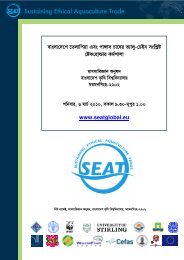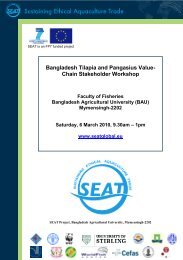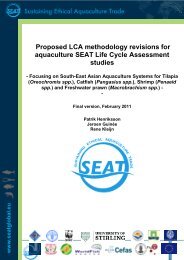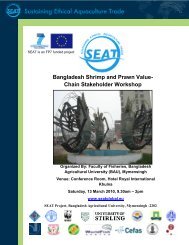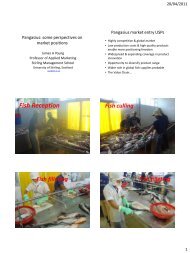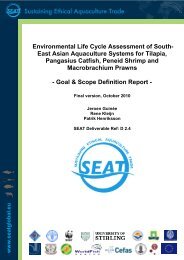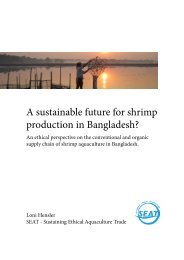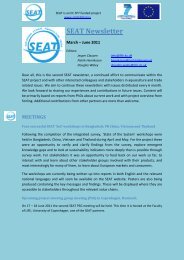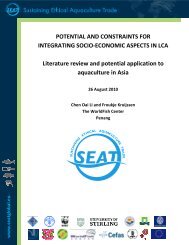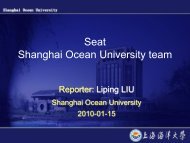D4.1 Review of Environmental Models - SEAT Global
D4.1 Review of Environmental Models - SEAT Global
D4.1 Review of Environmental Models - SEAT Global
Create successful ePaper yourself
Turn your PDF publications into a flip-book with our unique Google optimized e-Paper software.
flows to display the route <strong>of</strong> conceptual data flow through the model (Costanza & Gottlieb,<br />
1998). By defining rules and algorithms to control this data transfer between objects, system<br />
dynamic models can be built.<br />
STELLA is a visual modelling tool, with a User-Friendly interface, which has been utilised in<br />
both business and academia (Isee systems, 2010). This interface has allowed STELLA to be<br />
one <strong>of</strong> the most widely used <strong>of</strong> the modelling s<strong>of</strong>tware packages available to date (Costanza<br />
& Voinov, 2001). <strong>Models</strong> are constantly being developed for different systems and areas <strong>of</strong><br />
research and circulated through application <strong>of</strong> a VLE version <strong>of</strong> the s<strong>of</strong>tware. This not only<br />
allows re-use and flexible programming <strong>of</strong> models by many users but the estabilishment <strong>of</strong> a<br />
library <strong>of</strong> routines which can be incorporated into a variety <strong>of</strong> models (Isee systems. 2010).<br />
STELLA has been widely used for management in environmental systems, for example for<br />
use in the US to model changes in culture <strong>of</strong> sugarcane in Brazil for the production <strong>of</strong><br />
ethanol for use as a bi<strong>of</strong>uel (Dias De Oliveira et al., 2005). It has also been used extensively<br />
to develop models for prediction <strong>of</strong> climate change on environmental systems. More<br />
recently STELLA has being used increasingly to build models <strong>of</strong> aquatic systems including<br />
sites for aquaculture production and management (Grant et al., 1997), especially concerning<br />
nutrient cycling and material flow; common concerns for sustainable aquaculture (Pillay and<br />
Kutty, 2005).<br />
An example <strong>of</strong> models <strong>of</strong> systems dynamics developed in STELLA include a wetland model<br />
for the Olentangy River Wetland Research Park (ORWRP) (Zhang & Mitsch, 2005)<br />
Simulations were created <strong>of</strong> the hydrological processes and nutrient flow interactions<br />
between multi-wetland areas (Zhang & Mitsch, 2005). These models, which we based on a<br />
mass balance approach for nutrient flow, included evaporation and retention from the river<br />
as well as outside influences such as storm water additions. Subsequent field verification <strong>of</strong><br />
the models showed that they were a very accurate simulation <strong>of</strong> actual systems interactions.<br />
STELLA models <strong>of</strong> dynamic fluctuations within systems can be readily transferred to spatial<br />
modelling frameworks, such as GIS (Mazzoleni et al., 2003). Coupling a model developed<br />
through STELLA with GIS can provide the user more visually accessible information <strong>of</strong> what is<br />
happening within a system at different spatial scales, thus making it easier to convey the<br />
results from any given simulation to a non-specialist end-user group (Elshorbagy et al., 2005)<br />
1.2.3 Powersim TM<br />
Powersim is graphical interface object-oriented modelling s<strong>of</strong>tware, originally created for<br />
modelling business strategies (Ford, 2009; Powersim, 2010). However, this s<strong>of</strong>tware has<br />
been shown to provide an excellent modelling framework for dynamic modelling <strong>of</strong><br />
biological systems (Franco et al, 2006).<br />
Similar in nature to STELLA, Powersim has greater functionality and the ability to produce<br />
self standing, compiled models for easy dissemination and integration into other modelling<br />
frameworks such as GIS. The s<strong>of</strong>tware is also easily accessible to non-mathematicians and is<br />
particularly well designed for modelling spatial dynamics (Maxwell, 1999).<br />
Powersim has been used to model the uptake <strong>of</strong> nitrogenous substances by marine<br />
phytoplankton, namely the interactions between nitrate and ammonium within the<br />
environment and organism (Flynn et al, 1997). The model took into account transport <strong>of</strong><br />
ammonia and nitrate into the cell and its subsequent cellular level biochemical reactions.<br />
Page 7



